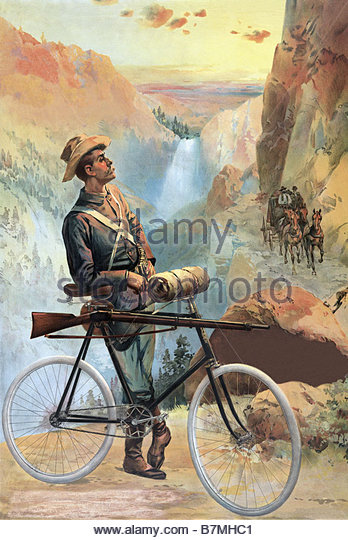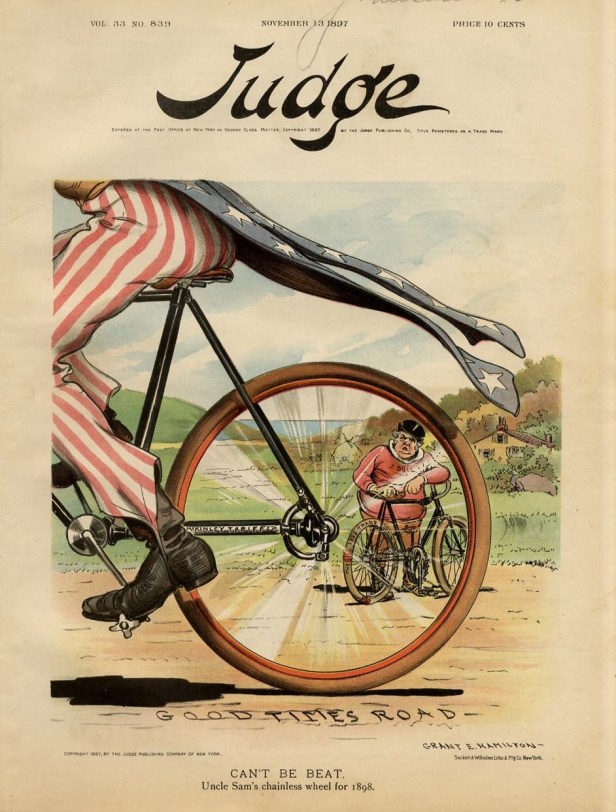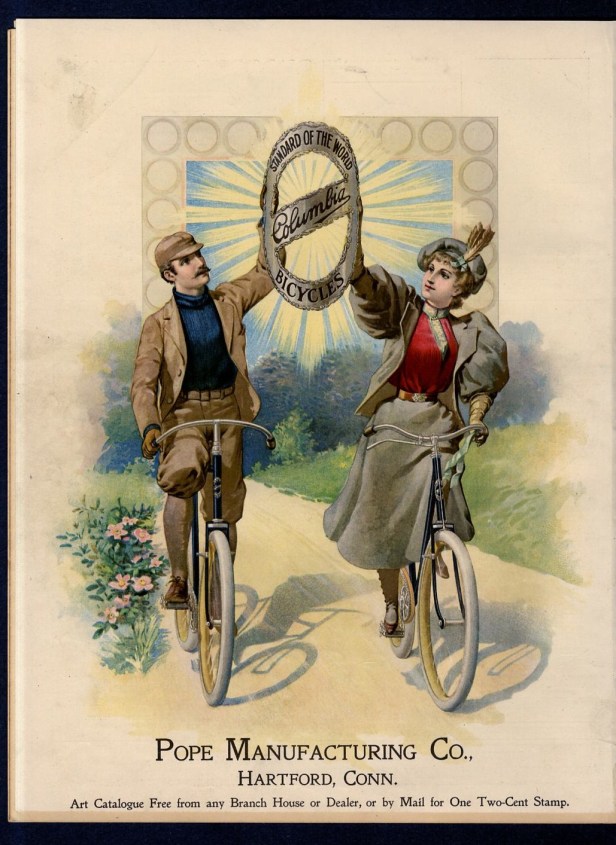Bicycles are so ubiquitous that we need to take this marvelous and revolutionary invention for granted. Bicycles predate the motorcar and back in the 19th century they became an affordable alternative to travel by horse and horse-drawn vehicle. The bike represented a kind of freedom people were never able to exercise before. They were used for basic transportation and soon became highly fashionable. There were bike clubs and bicycle races, clothing was designed to accommodate the needs of cycling. Both men and women rode bikes and cycling together became a means of courting and hooking up.
In the mid and later year of the 1800s, people were not bombarded by images of all sorts from an incredible number of sources as is the case today. Starting in 1839 there were photographs. Printing images in magazines came later, but there were various kinds of printed posters and images. And one kind of printed image was the chromolithograph.
[caption id="attachment_9640" align="alignnone" width="348"]

Source: http://bit.ly/31gP2Kw[/caption]
[caption id="attachment_9639" align="alignnone" width="616"]

Source: http://bit.ly/31gP2Kw[/caption]
According to Wikipedia:
Chromolithography is a unique method for making multi-colour prints. This type of colour printing stemmed from the process of lithography,[1] and includes all types of lithography that are printed in colour.[citation needed] When chromolithography is used to reproduce photographs, the term photochrome is frequently used. Lithographers sought to find a way to print on flat surfaces with the use of chemicals instead of raised relief or recessed intaglio techniques.[2]
Chromolithography became the most successful of several methods of colour printing developed by the 19th century; other methods were developed by printers such as Jacob Christoph Le Blon, George Baxter, and Edmund Evans, and mostly relied on using several woodblocks with the colours. Hand-colouring also remained important; elements of the official British Ordnance Survey maps were coloured by hand by boys until 1875. The initial technique involved the use of multiple lithographic stones, one for each colour, and was still extremely expensive when done for the best quality results. Depending on the number of colours present, a chromolithograph could take even very skilled workers months to produce. However much cheaper prints could be produced by simplifying both the number of colours used and the refinement of the detail in the image. Cheaper images, like advertisements, relied heavily on an initial black print (not always a lithograph), on which colours were then overprinted. To make an expensive reproduction print as what was once referred to as a “chromo”, a lithographer, with a finished painting in front of him, gradually created and corrected the many stones using proofs to look as much as possible like the painting, sometimes using dozens of layers.[3]
[caption id="attachment_9637" align="alignnone" width="616"]

Source: http://bit.ly/31gP2Kw[/caption]
Because the bicycle was so important in popular culture of the time, there were thousands of bicycle chromolithographs created. Many chromolithographs are highly collectible. According to the PBS Antiques Roadshow program:
If you’re interested in collecting antique oil paintings, but you don’t have much money to invest, Christopher Lane, of The Philadelphia Print Shop, might have an attractive alternative: chromolithographs.
Learn about the printmaking process that brought color to the masses
“The [chromolithograph] prints are wonderful in terms of their decorative appeal and quality,” Chris says, “and they are under-appreciated today.” They are also fairly easy to find, and come in a variety of sizes and prices.
In the late 19th century, many chromolithographs were sold for under $10 and were hailed as “the democracy of art” for middle-class families. “The blues, the browns, the reds, they all were layered up, and this gave them texture and richness and feel of an oil painting,” Chris says. Heavy oil-based inks were used to create the effect, and they have prevented these lithographs from fading over time. Today, the casual eye is still fooled.
“A lot of people come into our booth at antique shows or into our shop and they think they’re looking at original oil paintings,” Chris says. “The quality is that good.”
[caption id="attachment_9635" align="alignnone" width="616"]

Source: http://bit.ly/31gP2Kw[/caption]
But collecting anything successfully requires a bit of research, knowledge and acquired expertise. According to the
Chicago Antiques Guide “How To Tell A Chromolithograph”:
If you are looking at buying an old poster that is supposed to be from the 1930’s or earlier, make sure that it is a stone lithograph and not a color separation. Many old posters have been reproduced using more modern color separation techniques.
To tell the difference, you will need a strong magnifier. A 10x jewelers loupe is ideal, but a 5x pocket magnifier may work if your eyes are pretty good and you have an idea of what to look for. First, let’s look at a black and white lithograph from the early 1880’s(on the left) and a chromolithograph from the 1890s (on the right). Remember that lithographs are printed from stone and will have the grain of the stone in the print. You will see “dots” of color, but they will be irregular when compared to the “dots” in a color separation
[caption id="attachment_9633" align="alignnone" width="616"]

Source: http://bit.ly/31gP2Kw[/caption]
*******************************************************

Bill Dobbins is a professional photographer, videographer and writer based in Los Angeles. His work has been exhibited as fine art in two museums, a number of galleries, and he has published eight books, including two fine art photo books:
The Women: Photographs of The Top Female Bodybuilders (Artisan)
Modern Amazons (Taschen)
WEBSITES
BILL DOBBINS PHOTOGRAPHY
www.billdobbinsphotography.com
BILL DOBBINS ART
www.billdobbinsart.com
FEMALE PHYSIQUE SITES
www.billdobbins.com
EMAIL:
billdobbinsphoto@gmail.com
[caption id="attachment_9630" align="alignnone" width="616"]

Source: http://bit.ly/31gP2Kw[/caption]
 Source: http://bit.ly/31gP2Kw[/caption]
[caption id="attachment_9639" align="alignnone" width="616"]
Source: http://bit.ly/31gP2Kw[/caption]
[caption id="attachment_9639" align="alignnone" width="616"] Source: http://bit.ly/31gP2Kw[/caption]
According to Wikipedia:
Chromolithography is a unique method for making multi-colour prints. This type of colour printing stemmed from the process of lithography,[1] and includes all types of lithography that are printed in colour.[citation needed] When chromolithography is used to reproduce photographs, the term photochrome is frequently used. Lithographers sought to find a way to print on flat surfaces with the use of chemicals instead of raised relief or recessed intaglio techniques.[2]
Chromolithography became the most successful of several methods of colour printing developed by the 19th century; other methods were developed by printers such as Jacob Christoph Le Blon, George Baxter, and Edmund Evans, and mostly relied on using several woodblocks with the colours. Hand-colouring also remained important; elements of the official British Ordnance Survey maps were coloured by hand by boys until 1875. The initial technique involved the use of multiple lithographic stones, one for each colour, and was still extremely expensive when done for the best quality results. Depending on the number of colours present, a chromolithograph could take even very skilled workers months to produce. However much cheaper prints could be produced by simplifying both the number of colours used and the refinement of the detail in the image. Cheaper images, like advertisements, relied heavily on an initial black print (not always a lithograph), on which colours were then overprinted. To make an expensive reproduction print as what was once referred to as a “chromo”, a lithographer, with a finished painting in front of him, gradually created and corrected the many stones using proofs to look as much as possible like the painting, sometimes using dozens of layers.[3]
[caption id="attachment_9637" align="alignnone" width="616"]
Source: http://bit.ly/31gP2Kw[/caption]
According to Wikipedia:
Chromolithography is a unique method for making multi-colour prints. This type of colour printing stemmed from the process of lithography,[1] and includes all types of lithography that are printed in colour.[citation needed] When chromolithography is used to reproduce photographs, the term photochrome is frequently used. Lithographers sought to find a way to print on flat surfaces with the use of chemicals instead of raised relief or recessed intaglio techniques.[2]
Chromolithography became the most successful of several methods of colour printing developed by the 19th century; other methods were developed by printers such as Jacob Christoph Le Blon, George Baxter, and Edmund Evans, and mostly relied on using several woodblocks with the colours. Hand-colouring also remained important; elements of the official British Ordnance Survey maps were coloured by hand by boys until 1875. The initial technique involved the use of multiple lithographic stones, one for each colour, and was still extremely expensive when done for the best quality results. Depending on the number of colours present, a chromolithograph could take even very skilled workers months to produce. However much cheaper prints could be produced by simplifying both the number of colours used and the refinement of the detail in the image. Cheaper images, like advertisements, relied heavily on an initial black print (not always a lithograph), on which colours were then overprinted. To make an expensive reproduction print as what was once referred to as a “chromo”, a lithographer, with a finished painting in front of him, gradually created and corrected the many stones using proofs to look as much as possible like the painting, sometimes using dozens of layers.[3]
[caption id="attachment_9637" align="alignnone" width="616"] Source: http://bit.ly/31gP2Kw[/caption]
Because the bicycle was so important in popular culture of the time, there were thousands of bicycle chromolithographs created. Many chromolithographs are highly collectible. According to the PBS Antiques Roadshow program:
If you’re interested in collecting antique oil paintings, but you don’t have much money to invest, Christopher Lane, of The Philadelphia Print Shop, might have an attractive alternative: chromolithographs.
Source: http://bit.ly/31gP2Kw[/caption]
Because the bicycle was so important in popular culture of the time, there were thousands of bicycle chromolithographs created. Many chromolithographs are highly collectible. According to the PBS Antiques Roadshow program:
If you’re interested in collecting antique oil paintings, but you don’t have much money to invest, Christopher Lane, of The Philadelphia Print Shop, might have an attractive alternative: chromolithographs.
 Source: http://bit.ly/31gP2Kw[/caption]
But collecting anything successfully requires a bit of research, knowledge and acquired expertise. According to the Chicago Antiques Guide “How To Tell A Chromolithograph”:
If you are looking at buying an old poster that is supposed to be from the 1930’s or earlier, make sure that it is a stone lithograph and not a color separation. Many old posters have been reproduced using more modern color separation techniques.
To tell the difference, you will need a strong magnifier. A 10x jewelers loupe is ideal, but a 5x pocket magnifier may work if your eyes are pretty good and you have an idea of what to look for. First, let’s look at a black and white lithograph from the early 1880’s(on the left) and a chromolithograph from the 1890s (on the right). Remember that lithographs are printed from stone and will have the grain of the stone in the print. You will see “dots” of color, but they will be irregular when compared to the “dots” in a color separation
[caption id="attachment_9633" align="alignnone" width="616"]
Source: http://bit.ly/31gP2Kw[/caption]
But collecting anything successfully requires a bit of research, knowledge and acquired expertise. According to the Chicago Antiques Guide “How To Tell A Chromolithograph”:
If you are looking at buying an old poster that is supposed to be from the 1930’s or earlier, make sure that it is a stone lithograph and not a color separation. Many old posters have been reproduced using more modern color separation techniques.
To tell the difference, you will need a strong magnifier. A 10x jewelers loupe is ideal, but a 5x pocket magnifier may work if your eyes are pretty good and you have an idea of what to look for. First, let’s look at a black and white lithograph from the early 1880’s(on the left) and a chromolithograph from the 1890s (on the right). Remember that lithographs are printed from stone and will have the grain of the stone in the print. You will see “dots” of color, but they will be irregular when compared to the “dots” in a color separation
[caption id="attachment_9633" align="alignnone" width="616"] Source: http://bit.ly/31gP2Kw[/caption]
*******************************************************
Source: http://bit.ly/31gP2Kw[/caption]
*******************************************************
 The Women: Photographs of The Top Female Bodybuilders (Artisan)
Modern Amazons (Taschen)
WEBSITES
BILL DOBBINS PHOTOGRAPHY
www.billdobbinsphotography.com
BILL DOBBINS ART
www.billdobbinsart.com
FEMALE PHYSIQUE SITES
www.billdobbins.com
EMAIL: billdobbinsphoto@gmail.com
[caption id="attachment_9630" align="alignnone" width="616"]
The Women: Photographs of The Top Female Bodybuilders (Artisan)
Modern Amazons (Taschen)
WEBSITES
BILL DOBBINS PHOTOGRAPHY
www.billdobbinsphotography.com
BILL DOBBINS ART
www.billdobbinsart.com
FEMALE PHYSIQUE SITES
www.billdobbins.com
EMAIL: billdobbinsphoto@gmail.com
[caption id="attachment_9630" align="alignnone" width="616"] Source: http://bit.ly/31gP2Kw[/caption]
Source: http://bit.ly/31gP2Kw[/caption]





